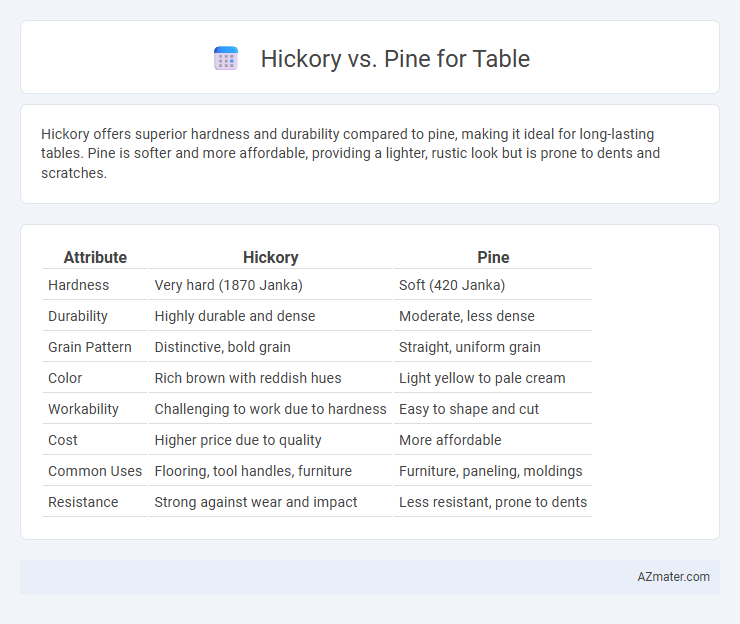Hickory offers superior hardness and durability compared to pine, making it ideal for long-lasting tables. Pine is softer and more affordable, providing a lighter, rustic look but is prone to dents and scratches.
Table of Comparison
| Attribute | Hickory | Pine |
|---|---|---|
| Hardness | Very hard (1870 Janka) | Soft (420 Janka) |
| Durability | Highly durable and dense | Moderate, less dense |
| Grain Pattern | Distinctive, bold grain | Straight, uniform grain |
| Color | Rich brown with reddish hues | Light yellow to pale cream |
| Workability | Challenging to work due to hardness | Easy to shape and cut |
| Cost | Higher price due to quality | More affordable |
| Common Uses | Flooring, tool handles, furniture | Furniture, paneling, moldings |
| Resistance | Strong against wear and impact | Less resistant, prone to dents |
Introduction to Hickory and Pine Wood
Hickory and pine are popular hardwoods used in table making, each offering distinct characteristics in durability and aesthetics. Hickory wood is known for its exceptional strength, hardness, and shock resistance, making it ideal for heavy-use tables that require longevity and resilience. Pine, a softer wood, provides a light, warm appearance with easy workability, favored for rustic and casual furniture that prioritizes affordability and ease of customization.
Key Differences Between Hickory and Pine
Hickory wood is significantly harder and denser than pine, making it more durable and resistant to dents and scratches, ideal for high-traffic tables. Pine features a lighter color with a more pronounced grain, offering a rustic and softer aesthetic but is more prone to warping and damage over time. Hickory's strength supports heavy use but tends to be more expensive, while pine is cost-effective and easier to work with for DIY projects.
Appearance: Grain, Color, and Texture
Hickory tables showcase a bold, dramatic grain pattern with contrasting light and dark streaks, offering a rugged, rustic appearance. Pine features a softer, more uniform grain with a pale yellow to light brown color, creating a warm and inviting look. The texture of hickory is dense and coarse, providing durability, while pine has a smoother, softer texture that is easier to work with but more prone to dents.
Durability and Hardness Comparison
Hickory ranks higher in durability and hardness compared to pine, boasting a Janka hardness rating of around 1,820, which makes it highly resistant to dents and wear in tables. Pine, with a Janka hardness of approximately 380, is much softer and more prone to scratches and dents, making it less suitable for heavy-use surfaces. The dense grain structure of hickory enhances its strength and longevity, ideal for robust, long-lasting furniture.
Workability: Ease of Cutting and Shaping
Hickory offers excellent workability due to its density and hardness, allowing for precise cutting and shaping while maintaining durability. Pine, being a softer wood, is easier to cut and shape but may be prone to dents and may require more careful handling during intricate work. Both woods are suitable for furniture making, but pine's lighter weight and softer texture provide greater ease in detailed shaping and sanding.
Cost and Availability
Hickory tables typically cost more due to the wood's density, durability, and distinct grain patterns, making it a premium choice for furniture. Pine is generally more affordable and widely available, as it grows faster and is harvested more frequently, making it an economical option for table production. Availability of pine surpasses hickory in most regions, ensuring easier access and quicker turnaround times for buyers.
Maintenance and Longevity
Hickory tables offer superior durability and long-lasting performance due to their dense hardwood structure, requiring minimal maintenance compared to pine. Pine tables, while more affordable and easier to work with, are softer and prone to dents and scratches, necessitating more frequent refinishing and care to maintain appearance. Choosing hickory enhances longevity with less upkeep, making it ideal for high-traffic or heavily used furniture.
Suitability for Different Table Types
Hickory's dense grain and durability make it ideal for heavy-use tables like dining or work tables, where strength and resistance to dents are essential. Pine's softer texture and lighter weight suit casual furniture such as side tables or coffee tables, offering ease of shaping and a rustic aesthetic. For high-traffic or functional tables requiring longevity, hickory is preferred, while pine is better for decorative or less frequently used pieces.
Environmental Impact and Sustainability
Hickory and pine have distinct environmental impacts and sustainability profiles that influence their suitability for tables. Hickory, a dense hardwood, is slower-growing and requires longer harvesting cycles, which can lead to greater environmental strain if not sourced responsibly, but its durability often results in longer-lasting furniture, reducing waste over time. Pine, a fast-growing softwood, is typically more sustainable due to quicker regeneration rates and widespread availability, making it a popular choice for eco-friendly furniture when obtained from sustainably managed forests certified by organizations like FSC.
Which Wood Should You Choose for Your Table?
Hickory offers exceptional durability and resistance to wear, making it ideal for heavy-use tables, while pine is softer, more affordable, and easier to work with but prone to dents and scratches. The choice depends on your priorities: select hickory for a long-lasting, sturdy table with a rich, dense grain, or pine for a lightweight, budget-friendly option with a warm, rustic appearance. Consider the table's function, room ambiance, and maintenance requirements to determine the best wood type for your needs.

Infographic: Hickory vs Pine for Table
 azmater.com
azmater.com